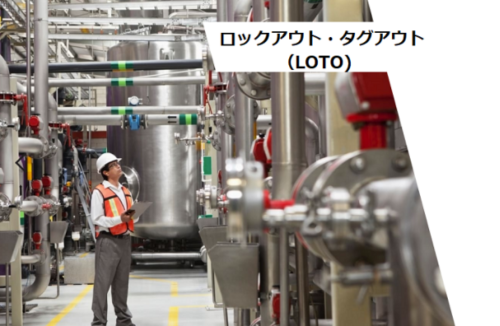The lock-out tag-out (LOTO) system is a critical procedure for safeguarding personnel operating, servicing, inspecting, and maintaining machinery facilities from hazards.
"Lockout" refers to the act of shutting off power sources such as breakers, switches, valves, etc., and then attaching and locking devices during maintenance of machinery and equipment. A "tagout" is a type of warning tag that is attached to a secure location locked by a lockout device. Machines and equipment will not be restarted until the tag is removed.
"Lockout" and "Tagout" are used together to prove and clarify the disconnection of the power source. There are also a number of safety standards to base when considering the design of a lockout system.
ISO 14118-2000 ・CSA Z460-2005 ・ANSI Z244.1-2003 ・OSHA 1910.147
The Lockout Tagout (LOTO) system applies to all energy sources, but fluid power has its own set of challenges based on the physics involved. Below are some design guidelines to keep in mind when designing a pneumatic lockout system.
- The energy disconnect device should be unique in appearance compared to other ON/OFF devices.
- Energy isolation devices must be able to quickly exhaust dangerous pneumatic energy. (Large Exhaust) - Energy cut-off devices must be lockable in the OFF position only.
- The energy disconnect device requires only two operating positions. (ON and OFF) - The system must include a visible indication of the safe state (free of hazardous energy) (Visualization)
In the United States, violations of not following lockout tagout (LOTO) system procedures are still among the top ten summons by OSHA.
As a result, the accidents and events that occur negatively affect worker morale and productivity. In other words, developing proper lock-out tag-out (LOTO) system procedures in-house is the first challenge, but worker compliance can be the biggest challenge.
Pneumatic lockouts ensure employee safety and there are four main concerns that should be addressed to increase the likelihood that the procedure will be carried out:
- Simplify lockout procedures
- Time for the machine to reach a safe state
- Confirmation of safe state
- Safely restore air pressure
1. Simplification of lockout procedures
Simplifying the pneumatic lockout procedure involves eliminating unnecessary steps in the process. For example, using an energy isolation device that isolates and vents downstream energy in one function saves an extra step in the process instead of isolating and venting separately. Second, the direct application of one or more lockout devices without the need for additional equipment further simplifies the process.
2. Time required for the machine to reach a safe state
When dealing with pneumatics, “time” until a safe state is reached is important. There are several types of typical pneumatic lockout systems.
Shutoff and exhaust are provided by separate valves.
1. Using separate isolation and venting devices requires additional steps and can leave dangerous pressure in the system. The flow of energy ceases, but it is very likely that trapped pressure remains. Having his second step unnecessary increases the chances of a dangerous situation that can be overlooked by workers focused on keeping the production line running.
A single valve shuts off and vents, but exhaust is through a very small vent.
2. If the device used for venting vents downstream pressure through a small hole, such as many locking ball valves, the lockout device must be activated before a safe state (removing dangerous energy from the system) . state) can result in very long delays . A typical pneumatic circuit (pipes, headers, cylinders, etc.) with a volume of 227 L (≈8 cubic feet) can be exhausted through a lockout device in as little as 30 seconds if it has a large exhaust port. It takes more than 11 minutes and 30 seconds to evacuate the same capacity with a general depressurization valve (locking ball valve) with a small exhaust port. This means as much as 11 minutes of lost productivity as the system depressurizes before workers can . It also represents a long 11 minutes during which an operator could unknowingly or knowingly enter a work area with machines still under pressure.
Shutoff and venting devices are integrated in one valve with high volume venting.
3. One-step process facilitates adherence to worker lockout procedures. It eliminates the second step in the procedure ( actuating another valve or waiting for dangerous energy to drain from the system), resulting in simultaneously reducing production costs.
3. Confirmation of safe conditions
A suitable lockout system must provide the operator with a means of verifying that hazardous energy has been removed. This can be as simple as a pop-up indicator or pressure gauge attached to the pressure indicator port of the energy isolation device. It is also effective to include a pressure switch to communicate with the system process control system.
4. Restore air pressure safely
Some movement can occur when air is resupplied to an evacuated system. In some cases, this action can occur unexpectedly or abruptly and damage the equipment. In this case, a soft-start device can be used to gradually increase the pressure to about 50% of line pressure before fully opening the valve and reaching 100% flow. These devices are adjustable and it is possible to control the pressure rise during the initial run and thus also the speed. Depending on the mechanical design, multiple soft-start devices may be required.
Summary
A well-designed lock-out tag-out (LOTO) system and adherence to its procedures can improve both safety and productivity. Safety will be the most important driver for implementing proper lockout procedures, but adding a productivity-enhancing factor will improve her ROI on the project. In short, ensuring safety is a win-win for management and employees for any business.
Additional information on safety standards is also available from the following sites:
- ISO - International Organization for Standardization - www.iso.org
- Canadian Center for Occupational Health and Safety - www.ccohs.ca
- American National Standards Institute - www.ansi.org
- UNITED STATES DEPARTMENT OF LABOR - www.osha.gov

